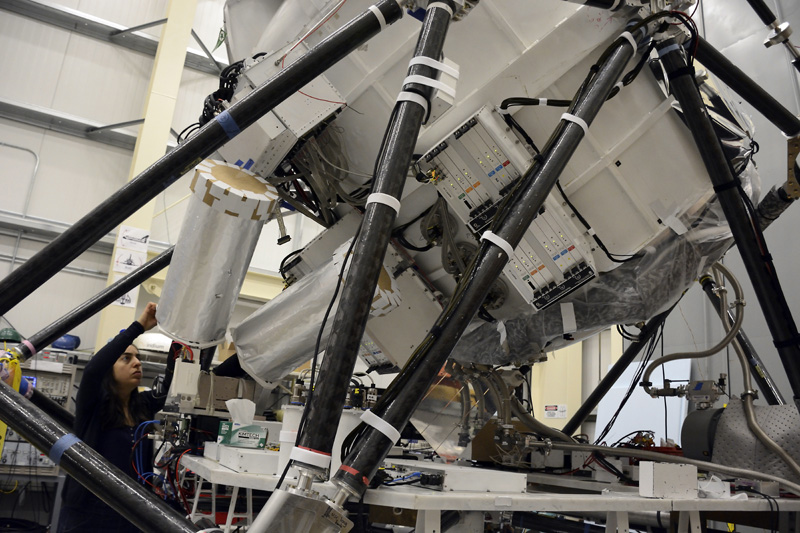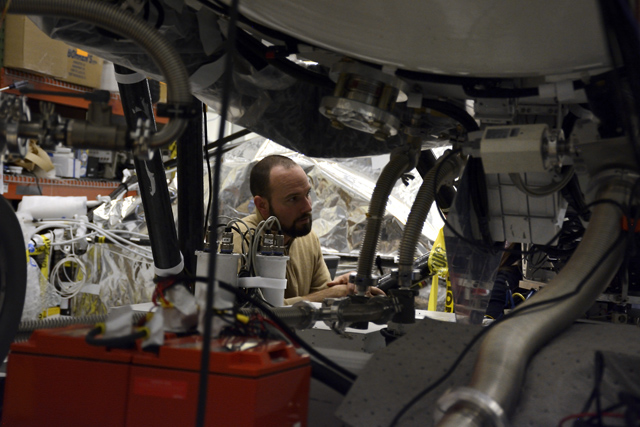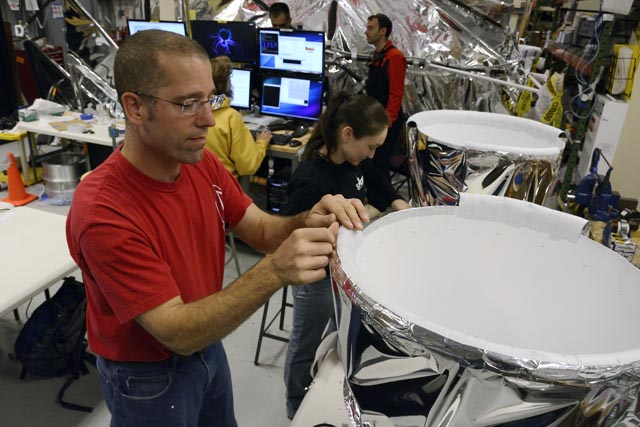A sticky problemSPIDER seeks clues to the enigma of how the universe first expandedPosted April 27, 2015
About a month before launching a three-ton telescope – the culmination of seven years of work – into the atmosphere above Antarctica aboard a balloon that would eventually inflate to the size of a football stadium, William Jones waxes a little philosophical. His instrument – SPIDER SPIDER was headed to the stratosphere, some 35 kilometers overhead, to catch a lift on the polar vortex, a reliable atmospheric phenomenon that forms around Antarctica each year. It’s the most sensitive instrument of its kind ever built, according to Jones, with a singular mission: detect the impossibly faint signal from when the universe expanded faster than the speed of light, a theory known as cosmological inflation. Photo Credit: SPIDER collaboration/Antarctic Photo Library
Antarctica as seen from 35 kilometers above the Earth by the SPIDER telescope.
The goal has become the raison d’être among cosmologists looking to link the major theories that cover life, the universe and everything – well, at least the universe, in the short term. A number of ground-based telescopes – including several at Amundsen-Scott South Pole Station, funded and supported by the National Science Foundation – are also sweeping the skies for the fingerprint of inflation. Jones extolls on the virtues of balloon-borne astrophysics from those experiments grounded to the Earth, foremost among them being that this poor man’s version of a satellite gets above the atmospheric fray of emissions that can swamp sensitive detectors. “Twenty days of our observing is like two years of their observing,” says Jones, an assistant professor at Princeton University. Of course, flinging a telescope into pseudo orbit around Antarctica, like snapping a rubber band into the air, has its own inherent risk, Jones admits. “It comes with the disadvantage of being a Hail Mary pass,” he says during a late November day at the Long Duration Balloon facility where SPIDER is housed in one of two tall hangars on the Ross Ice Shelf about 10 kilometers from McMurdo Station. “You have one opportunity to fly it, and if everything works well, then it’s great. Touchdown.” Spoiler alert: Jones and his team – led by Princeton University, the University of Toronto, the California Institute of Technology/NASA Jet Propulsion Lab and Case Western Reserve – successfully launched SPIDER on Jan. 1. It would take data for about 16 days before dropping back to Antarctica. The hardware that stored the data aboard the spacecraft was later recovered by the British Antarctic Survey about 2,300 kilometers from McMurdo Station. In other words, touchdown. The game, however, is far from over, as the real grind down the field begins to catch the telltale signal of inflation, which posits that the universe expanded exponentially fractions of a second after its birth. The field of play, in this case, is the cosmic microwave background (CMB), the so-called afterglow of the Big Bang. About 380,000 years after the universe burst into existence, it cooled enough to allow electrons to combine with nuclei (what’s known as recombination). The universe glowed with light before recombination; but after recombination, it became transparent. The brilliant light from the Big Bang that started as ultra-high energy gamma rays stretched into X-rays, was visible light at recombination, and has now stretched all the way to microwaves. Physicists use the CMB in various ways to look back into the nearly 14-billion-year evolution of the universe, including indirectly at cosmological inflation. Prevailing theories hold that the traumatic expansion of space-time that occurred would leave distinctive scars – gravitational waves – on the surface of the CMB. These particular gravity waves, referred to as B-mode polarization, have a spiral quality called curl, which would look like hurricanes in a hypothetical map of the polarization of the CMB. SPIDER actually uses six telescopes, with more than 2,000 detectors, to weave its web to capture that signal on the picture it creates. It operates a bit like a thermal digital camera, looking for a temperature change in the CMB of less than one-billionth of a degree Kelvin. The CMB itself is about 3 degrees Kelvin, on a temperature scale where absolute zero is the state at which all thermal motion ceases. That’s cold. So cold, in fact, that one of the primary systems aboard SPIDER involves cooling its detectors down to about a quarter of a degree above absolute zero through complex cryogenics using liquid helium. “Cryogenics is particularly complicated,” notes John Ruhl, a co-principal investigator on SPIDER from Case Western University. “Whenever you’re trying to keep things cool for [up to] 20 days that’s not easy, especially given the mass and power limitation of a balloon-borne payload.” In fact, the whole experiment, powered by a solar array, only consumes a little bit more energy than a desktop computer, according to Jones. “It has to work off just a trickle of energy coming into it,” he says. Another subsystem of the spacecraft employs star cameras and laser gyroscopes so that the team knows exactly where the multi-telescope instrument – looking like the back of a rocket when assembled – is pointing as it sways below the balloon. 
Photo Credit: Peter Rejcek
A machine delivers a dewar of liquid helium to the SPIDER hangar. Another balloon-borne experiment, ANITA III, can be seen in the background.
Inflationary theory holds sway over some key parts of cosmology. It helps explain the origin of large-scale structures in the universe such as galaxies and galaxy clusters. Quantum fluctuations in the inflationary epoch, shot to cosmic scale, became “seeds” for the eventual growth of such structures. Many theorists also believe inflation explains why the universe appears to be the same in all directions, among other properties. Jones explains that the detection of the signature of gravitational waves in the CMB would wed what has been thus far an inconsolable pair of theories – Einstein’s theory of general relativity and quantum field theory. Einstein covers gravity, while quantum mechanics accounts for electromagnetic, weak, and strong force interactions on much smaller scales. A grand, unifying theory, sometimes referred to as quantum gravity, remains elusive. That’s part of the impetus behind SPIDER and sister experiments like BICEP, a series of telescopes that have operated at the South Pole Station since the mid-2000s. Last year, physicists on the BICEP2 instrument announced the first discovery of B-mode polarization, only to have the finding later dismissed as galactic dust emissions. A new generation telescope, BICEP3, was recently installed at the South Pole, and it began taking data earlier this year to continue the search for B-mode gravitational waves. “In terms of questions in fundamental physics that are outstanding and are starved for data, this is really at the top of the list,” Jones says. “It would be a direct probe of physics from an epoch that has never been probed before.” SPIDER is funded and supported largely by a grant from NASA (Award No NNX12AE95G) and the David and Lucille Packard Foundation, as well as the National Science Foundation, the Columbia Scientific Balloon Facility, the Natural Sciences and Engineering Research Council of Canada, and the Canadian Space Agency. |



For USAP Participants |
For The Public |
For Researchers and EducatorsContact UsU.S. National Science FoundationOffice of Polar Programs Geosciences Directorate 2415 Eisenhower Avenue, Suite W7100 Alexandria, VA 22314 Sign up for the NSF Office of Polar Programs newsletter and events. Feedback Form |





